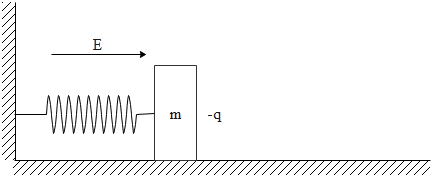
A block of mass m containing a net negative charge q is placed on a frictionless horizontal table and is connected to a wall through an unstretched spring of spring constant $\mathrm{k}$ as shown. If horizontal electric field E parallel to the spring is switched on, then the maximum compression of the spring is:

(A) $\sqrt{\dfrac{2 q E}{k}}$
(B) $2 \mathrm{qE} / \mathrm{k}$
(C) $\mathrm{qE} / \mathrm{k}$
(D) Zero
Answer
216.9k+ views
Hint: Electric field is defined as the electric force per unit charge. The direction of the field is taken to be the direction of the force it would exert on a positive test charge. The electric field is radially outward from a positive charge and radially in toward a negative point charge. Keeping this concept in mind and equating the formula for electric field with spring formula, we can solve the given problem.
Complete step by step solution
We can assume that,
mass of block $=\mathrm{m}$
charge on block $=\mathrm{q}$
spring constant of connected spring to block and wall $=k$
horizontal electric field $=E$
If a horizontal electric field is applied, an accelerating force acts in the right direction on the block. This force is balanced by spring force because spring is also connected to block. Let x be the maximum extension of spring.
So, spring force = electrostatic force
$\Rightarrow \mathrm{kx}=\mathrm{qE}$
$\Rightarrow x=q E / k$
We know, maximum extension of spring is no other than amplitude.
So, amplitude is $x=q E / k$.
Therefore, the correct answer is Option C.
Note: We must keep in mind the formula of electromagnetic field as well as the formula for the work done by a spring in case of solving such questions. We must memorize the values of the constants involved.
Complete step by step solution
We can assume that,
mass of block $=\mathrm{m}$
charge on block $=\mathrm{q}$
spring constant of connected spring to block and wall $=k$
horizontal electric field $=E$
If a horizontal electric field is applied, an accelerating force acts in the right direction on the block. This force is balanced by spring force because spring is also connected to block. Let x be the maximum extension of spring.
So, spring force = electrostatic force
$\Rightarrow \mathrm{kx}=\mathrm{qE}$
$\Rightarrow x=q E / k$
We know, maximum extension of spring is no other than amplitude.
So, amplitude is $x=q E / k$.
Therefore, the correct answer is Option C.
Note: We must keep in mind the formula of electromagnetic field as well as the formula for the work done by a spring in case of solving such questions. We must memorize the values of the constants involved.
Recently Updated Pages
JEE Atomic Structure and Chemical Bonding important Concepts and Tips

JEE Amino Acids and Peptides Important Concepts and Tips for Exam Preparation

Electricity and Magnetism Explained: Key Concepts & Applications

Chemical Properties of Hydrogen - Important Concepts for JEE Exam Preparation

JEE Energetics Important Concepts and Tips for Exam Preparation

JEE Isolation, Preparation and Properties of Non-metals Important Concepts and Tips for Exam Preparation

Trending doubts
JEE Main 2026: Application Form Open, Exam Dates, Syllabus, Eligibility & Question Papers

Derivation of Equation of Trajectory Explained for Students

Hybridisation in Chemistry – Concept, Types & Applications

Understanding the Angle of Deviation in a Prism

Understanding Collisions: Types and Examples for Students

How to Convert a Galvanometer into an Ammeter or Voltmeter

Other Pages
JEE Advanced Marks vs Ranks 2025: Understanding Category-wise Qualifying Marks and Previous Year Cut-offs

Units And Measurements Class 11 Physics Chapter 1 CBSE Notes - 2025-26

NCERT Solutions For Class 11 Physics Chapter 8 Mechanical Properties Of Solids

Motion in a Straight Line Class 11 Physics Chapter 2 CBSE Notes - 2025-26

NCERT Solutions for Class 11 Physics Chapter 7 Gravitation 2025-26

Understanding Atomic Structure for Beginners




